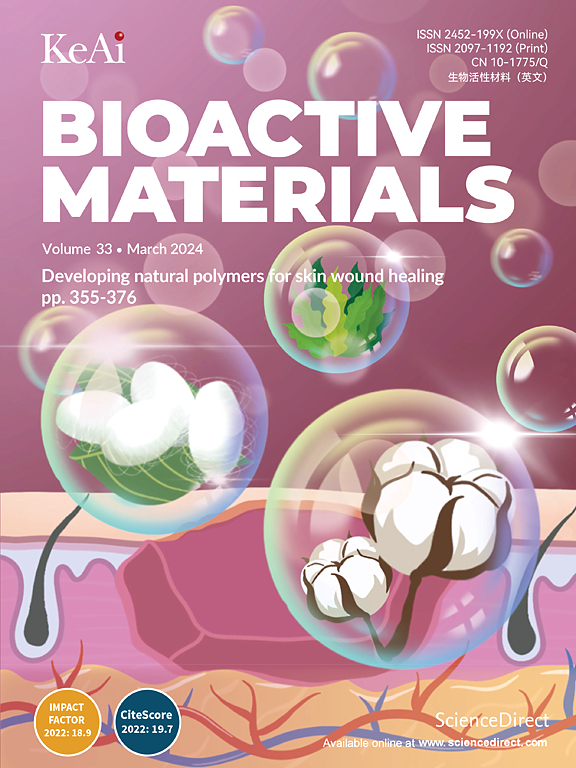Stromal-platelet membrane-inspired nanoparticles (SPIN) for targeted heart repair
IF 18
1区 医学
Q1 ENGINEERING, BIOMEDICAL
引用次数: 0
Abstract
Myocardial infarction (MI), commonly known as a heart attack, remains a leading cause of death worldwide. Standard treatments, such as coronary stent placement or coronary artery bypass graft surgery, aim to restore blood flow to ischemic myocardial tissue. However, a significant complication of these procedures is ischemia/reperfusion (I/R) injury, which occurs when blood flow is restored, triggering oxidative stress, inflammation, and calcium overload that can further damage the heart. To limit the I/R injury following the coronary recanalization of an MI heart, we designed stromal-platelet membrane-inspired nanoparticles (SPINs) that consist of a poly (lactic-co-glycolic acid) (PLGA) core, decorated by a dual membrane coating: a platelet membrane for precise adhesion to the damaged endothelium area and a stromal cell membrane to enhance receptor-ligand interactions and immune-evasiveness. This unique dual-membrane configuration synergistically reduces fibrosis and inflammation while promoting angiomyogenesis. This combination integrates the vascular injury targeting and immune-evasive properties of the nanoparticle, making this dual-membrane design a promising add-on intervention to augment post- percutaneous coronary intervention recovery, enhancing outcomes and offering potential improved cardiac repair.

基质血小板膜激发纳米颗粒(SPIN)用于靶向心脏修复
心肌梗死(MI),通常被称为心脏病发作,仍然是世界范围内死亡的主要原因。标准治疗,如冠状动脉支架置入或冠状动脉搭桥手术,旨在恢复缺血心肌组织的血液流动。然而,这些手术的一个重要并发症是缺血/再灌注(I/R)损伤,当血流恢复时,会引发氧化应激、炎症和钙超载,从而进一步损害心脏。为了限制心肌梗死心脏冠状动脉再通后的I/R损伤,我们设计了由聚乳酸-羟基乙酸(PLGA)核心组成的基质-血小板膜激发纳米颗粒(SPINs),由双膜涂层装饰:用于精确粘附受损内皮区域的血小板膜和用于增强受体-配体相互作用和免疫逃避的基质细胞膜。这种独特的双膜结构协同减少纤维化和炎症,同时促进血管生成。这种组合结合了纳米颗粒的血管损伤靶向性和免疫逃避特性,使这种双膜设计成为一种有希望的附加干预措施,以增强经皮冠状动脉介入治疗后的恢复,提高结果并提供潜在的改善心脏修复。
本文章由计算机程序翻译,如有差异,请以英文原文为准。
求助全文
约1分钟内获得全文
求助全文
来源期刊

Bioactive Materials
Biochemistry, Genetics and Molecular Biology-Biotechnology
CiteScore
28.00
自引率
6.30%
发文量
436
审稿时长
20 days
期刊介绍:
Bioactive Materials is a peer-reviewed research publication that focuses on advancements in bioactive materials. The journal accepts research papers, reviews, and rapid communications in the field of next-generation biomaterials that interact with cells, tissues, and organs in various living organisms.
The primary goal of Bioactive Materials is to promote the science and engineering of biomaterials that exhibit adaptiveness to the biological environment. These materials are specifically designed to stimulate or direct appropriate cell and tissue responses or regulate interactions with microorganisms.
The journal covers a wide range of bioactive materials, including those that are engineered or designed in terms of their physical form (e.g. particulate, fiber), topology (e.g. porosity, surface roughness), or dimensions (ranging from macro to nano-scales). Contributions are sought from the following categories of bioactive materials:
Bioactive metals and alloys
Bioactive inorganics: ceramics, glasses, and carbon-based materials
Bioactive polymers and gels
Bioactive materials derived from natural sources
Bioactive composites
These materials find applications in human and veterinary medicine, such as implants, tissue engineering scaffolds, cell/drug/gene carriers, as well as imaging and sensing devices.
 求助内容:
求助内容: 应助结果提醒方式:
应助结果提醒方式:


